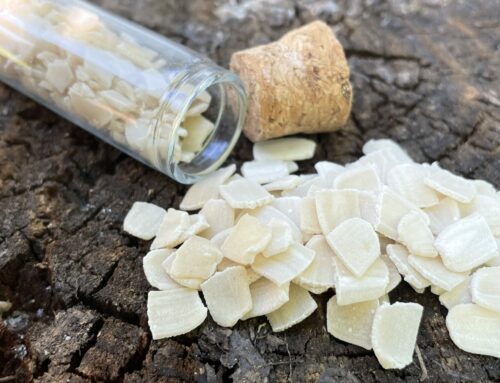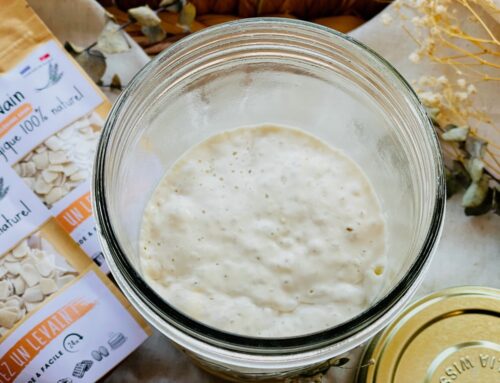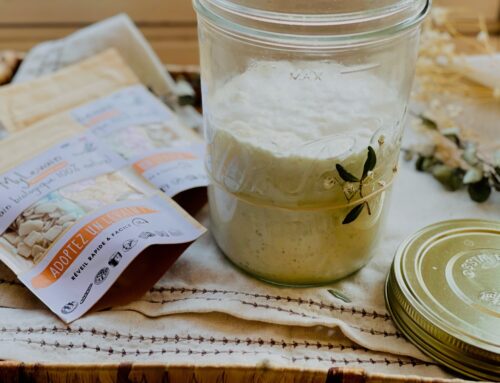You have just received your french sourdough starter « MyLevain Paillettes Millésime 2009, 50gr sachet« . Congratulations !
Discover the complete and illustrated instructions below
(to see instructions in French click here)
( to directly see the sourdough bread recipe click here )
1/Awakening your sourdough starter Vintage 2009
First of all, here is the video to understand how it works in 1 minute:
Here are the different steps
- Pour the entire sachet into a glass jar (1L) previously cleaned with cold water.
- Add 200g of organic T65 or T80 flour and 200g of water (18 to 20°): non-chlorinated water, natural mineral spring water, room temperature to cool.
- Mix everything vigorously, for about 30 seconds, to obtain a homogeneous paste (not all the glitter will dissolve immediately, and that is normal)
- Note the level with an elastic band, cover the jar (film or lid or simply a cloth) and leave to rest for 24 hours at room temperature (20 to 25°)
If your room is very cool (less than 18°) do not hesitate to place your jar near a heat source (box, lamp, radiator, etc.) - Between 16 and 24 hours, your sourdough will begin to wake up: bubbles will appear, its level will begin to rise and will reach its maximum height: this is the “peak” of rising.
Note: if after 24 hours your sourdough still does not rise or rises very little: don’t panic! This is because your sourdough was dried several weeks ago, and it just takes a little more time to wake up:
Wait until the end of the 24 hours
After 24 hours, if it has not yet risen: let it rest for another 3 to 6 hours, it should start to rise suddenly. This can happen because not all glitters are hydrated enough to begin with, and some are drier than others.
After 36 hours in total, if nothing happens: quickly give it another mini refreshment: add 50g of flour + 50g of water, stir to mix well, and leave to sit for 6 to 12 more hours. It should rise suddenly. Be careful of overflow!If despite your efforts nothing happens : check the following points:
- The water was too chlorinated: prefer bottled water, natural mineral water.
- Was the flour dosage done correctly? Your leaven should be pasty, semi-liquid. If it is too liquid, it is not normal. Add a little flour and wait a few more hours. As soon as it rises, it’s ready.
- The leaven was placed in a place that was too cool: it needs heat (20 to 25°)
- Was the water too hot? you must use cool water or at room temperature (18 to 20°) to wake up your sourdough, a temperature above 40° will damage the natural yeasts and bacteria present in the sourdough
- Be careful sometimes too: in the middle of summer, with extreme heat or heat waves, your sourdough can wake up in around 15 hours, and its level will drop very quickly (in less than an hour). Because heat accelerates the fermentation process and therefore the work of wild yeasts and lactic acid bacteria will be very rapid. Also when you arrive at your jar after 24 hours of rest, it may happen, under these conditions, that only a few bubbles remain on the surface. The simplest thing is to check the temperature of the room from the start (18 to 25° maximum). If in doubt, give it a « mini express refresh » with 50g of flour and 50g of water, and wait 1 more hour to see if its level rises correctly.
If despite this your sourdough still does not rise, do not hesitate to take a photo of its surface, note the batch number, and contact us on contact@mylevain.com
And do not forget ! as soon as your sourdough has awakened, and if you have not planned to use it during the day, give it another small meal (50g of flour/50g of water): you can then either keep it at room temperature another 24 hours more, or put it in the fridge so that it falls asleep until the next use. Check it approximately every 3 days at the beginning, and refresh it at least once a week for the first 3 months.
2/ USING YOUR SOURDOUGH
To use your sourdough, it’s very simple: there are 2 scenarios:
- Either you use your sourdough for the first time immediately after waking up (or during the day)
- or you can place it in the fridge, and you will use it in a few days.
In both cases, always use your sourdough after having previously refreshed it !
-
1st case (immediate use after waking up)
Your sourdough has just awakened after 24 hours, so its strength is sufficient, but not optimal. Wait until it is at the highest point in the jar before using it (24 to 36 hours depending on the season). Indeed, it is when it is at its highest that the number of yeasts and lactic acid bacteria are also at their highest. And your bread will be better (more beautiful, larger, better fermented and therefore more digestible and more nutritious, and it will keep better too).
At the peak of rising, take a dose of your sourdough starter: if you make a loaf with 1kg of flour, you will need between 150g and 200gr of sourdough.
Then, follow the sourdough bread recipe here (english version)
-
2nd case (use several days after waking up)
3 hours before use, take your sourdough starter out of the fridge.
Take half of the necessary dose: for example, if you make a loaf of bread with 1kg of flour, you will need a total of around 200g of sourdough.
You will therefore only take 100g of sourdough starter (A), which you will pour into a bowl or another jar (B).
You will add to this bowl (B) a refreshment of 1/2 volume of flour and 1/2 volume of water, so approximately 50g of flour and 50g of water (you can round up to 40g, it doesn’t change anything). Mix and let this jar rest until you notice the peak of rising (between 1 hour and 5 hours depending on the strength of your leaven, the temperature, the weather, etc.): this will be your « all-round » leaven, the one that will be mixed with the water in the recipe. You will have around 200g, enough to make several beautiful loaves with 1kg of flour in total.
Concerning your sourdough starter, before putting it back in the fridge, check its level. If you have only taken 100g, it can be put back directly in the fridge, and wait a few days until its weekly refreshment. But you can also complete it for a refresher: you have taken 100g of sourdough starter, you must therefore give it 50g of flour, and 50g of water. Mix, and quickly put it back in the fridge where it will stay until its next use. Monitor your sourdough starter carefully at the beginning every 3 days, to check if it is getting used to its new location.
3/ PRESERVATION OF YOUR SOURDOUGH
To keep your sourdough in the best conditions, simply place it in the fridge in a glass jar (Le Parfait 1L) and refresh it (feed it) approximately once a week (every 6 to 10 days). Cover it (no need to screw on the lid). Air exchange is needed from time to time. Some tips to follow to ensure longevity and strength for years to come:
Monitor your sourdough every week at least: it is a living being, it will have its moods, its needs. As soon as it gives off water (transparent or black on the surface), or changes structure (flabby, viscous), appearance, smell: take the jar out of the fridge, throw in a little surface leaven, stir everything well, then give it a refresh depending on its condition:
- If he is in good shape but just hungry: for 1 volume of sourdough, give him 1/2 volume of flour + 1/2 volume of water, stir, clean the edges with a sheet of paper towel or dry sponge, cover, put back in the fridge.
- If it is not in good shape (it has been forgotten for more than a week, has been cold, produces black water on the surface, viscous state without bubbles): take it out of the fridge quickly, empty half the jar, carry out a strong refreshment: for 1 volume of sourdough, 1 volume of flour and 1 volume of water. Stir and leave to rest for 1 hour before returning to the fridge.
4/ RECETTES
Discover the recipes with sourdough
MyLevain sourdough bread






